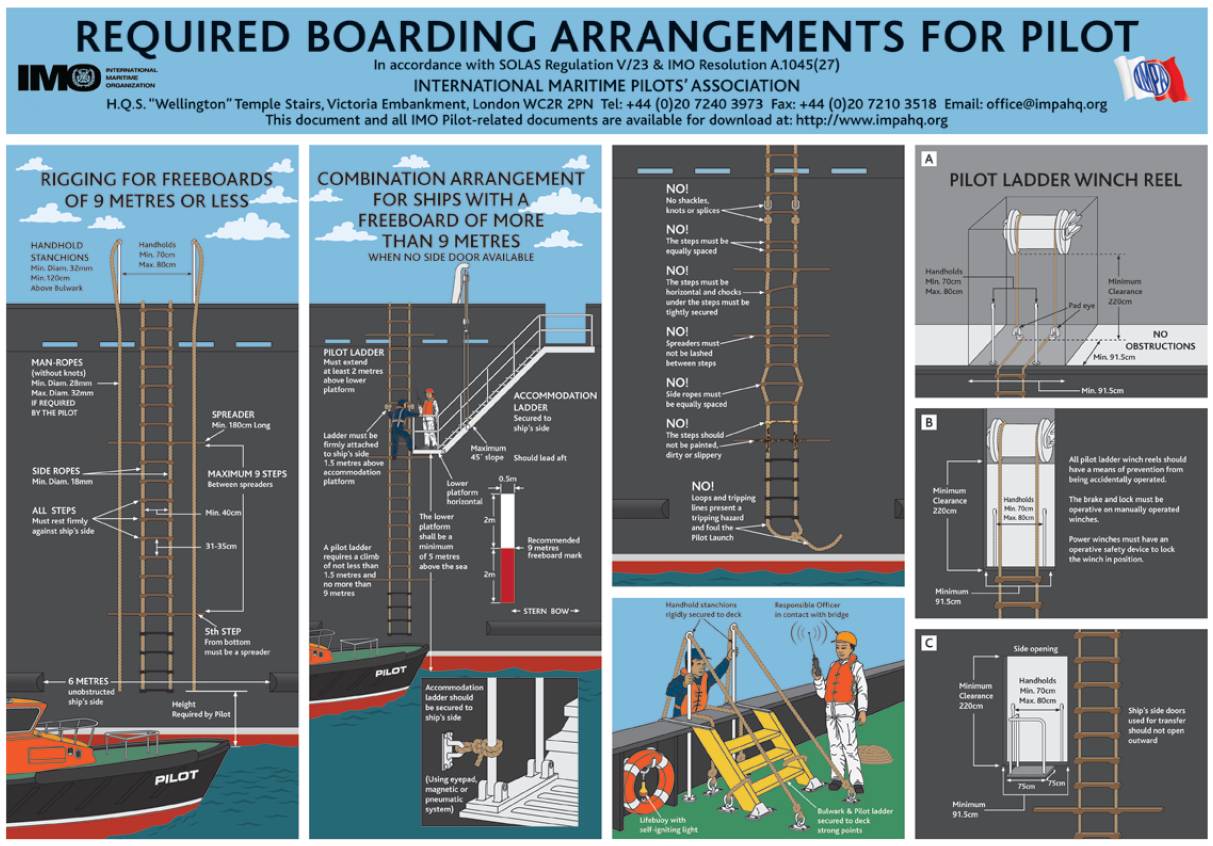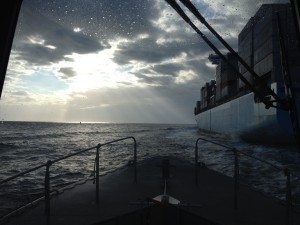- For domestic trade, pilot waters are defined by 46 CFR 7.65 and include the harbor and out to three miles offshore. For international trade, pilot waters are defined by Title 54 of the South Carolina State Law and include the harbor and the ship channel out to 15 miles offshore. Pilots are required when a vessel is underway in those waters.
- Boardings (embarking pilot) are normally done in the vicinity of Pilot Station A / Buoy “C” for drafts greater than 45 feet, in the vicinity of Pilot Station B / Buoy “2A” for drafts greater than 40 feet, and in the vicinity of the Pilot Station C / Buoy “6” for drafts less than 40 feet.
- Disembarkations are made whenever a vessel shall depart the Pilot Waters en route to sea.
- Pilots carry personal VHF transceivers. Please hail pilots on VHF Channel 16. Other channels monitored include 13 (for communications between vessels) and 14 (for communications with the Pilot Office).
Instructions for boarding ladders:
-
-
- Vessel speed should be 8 to 10 knots unless otherwise directed by the pilot.
- Head the vessel so that the pilot may embark or disembark on the lee side, away from the seas.
- Rig the pilot ladder with spreaders in accordance with SOLAS Regulations.
- The ladder must be in good repair. A sturdy and clean pilot ladder is appreciated by your pilot.
- Position the ladder approximately 2 to 2.5 meters, or about 8 feet, above the water. Allow no slack in the ladder on the deck.
- No boat rope or man ropes are required.
- No line or unmoused sister hooks shall be attached to the foot of the ladder.
- At night, provide a brilliant light shining forward, and so as not to shine into the pilot boat operator’s eyes, to illuminate the ladder.
- Attend the ladder with an officer equipped with a radiotelephone to communicate with the ship’s bridge. Provide an escort to and from the bridge.
- Have a ring buoy, and at night a float light, ready to toss overboard immediately in case the pilot falls.
-

Below are deep draft tables for the Wando Welch Terminal, Hugh Leatherman Terminal and the North Charleston Terminal. All tides are based upon Customhouse Reach Terminal predictions published in the Tide Book. If below average tide (5.2 ft.), or strong westerly winds that could affect tide, or if the latest soundings are less than the Project Depth, or high sea state conditions exist, additional restrictions may apply. Manager and/or Pilot can adjust based on excessive conditions of tide, weather or vessel characteristics.
| Maximum Draft | Boarding and Sailing times (Wando Welch Terminal and Hugh Leatherman Terminal) |
| 46’00” | No Restrictions. May move any time. |
| 46’01” to 47’00” | Vessel may move 1.5 hrs. after low water until 2.5 hrs. before the next low water. |
| 47’01” to 48’00” | Vessel may move 2.5 hrs. after low water until 3.5 hrs. before the next low water. |
| 48’01” to 49’00” | Vessel may move 3 hrs. after low water until 4 hrs. before the next low water. |
| 49’01” to 50’00” | Vessel may move 4 hrs. after low water until 5 hrs. before the next low water. |
| 50’01” to 51’00” | Vessel may move 5 hours after low water, arriving and sailing. |
| Vessel Draft | Inbound Boarding Time | Outbound Boarding Time |
| 40’00” | Anytime | Anytime |
| 40’01” To 41’00” | Low water- 1 hr. to High water +1 hr. | Any time |
| 41’01” To 42’00” | Low water To High Water | Low water +1 hr. To High Water + 2 hrs. |
| 42’01” To 43’00” | Low water +1 hr. To High Water + 5 hrs. | Low water + 2 hrs. To High water + 1 hr. |
| 43’01” To 44’00” | Low water + 2 hrs. To High Water + 5 hrs. | Low water + 3 hrs. To High water + 1 hr. |
| 44’01” To 45’00 | Low water + 3 hrs. To Low water + 5 hrs. | Low Water + 4 hrs. To High Water |
| 45’01” To 46’00” | Low water + 5 hrs. EXACT | Low water + 4 hrs. EXACT |

